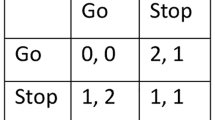Abstract
This chapter aims to show that there is a general theory of social ontology implicit in Amie Thomasson’s prolific philosophical work. In contrast to her books on fiction and metaphysics, this theory is not argued for in a single volume. The first objective is thus to make Thomasson’s important contribution to social ontology explicit by drawing out its core features. Despite its many advantages, such as its ability to take abstract social objects into account, there is a central difficulty: Thomasson’s new account of social groups is too narrow since it cannot accommodate opaque kinds of social groups. The second and related aim is to develop this objection and demonstrate that it must be resolved before we can take Thomasson’s theory of social ontology fully onboard. The chapter closes by suggesting that we can overcome this objection by even more pluralism—already a core feature in Thomasson’s social ontology.
Access this chapter
Tax calculation will be finalised at checkout
Purchases are for personal use only
Similar content being viewed by others
Notes
- 1.
- 2.
See for instance the debate between John Searle and Barry Smith on the so-called “free-standing Y-terms,” similar to abstract social objects (2003), and my suggestion (2007) that opaque kinds of social facts, referred to as macro-facts, are reducible to a collection of facts at the micro-level, a solution later adopted by Searle (2010).
- 3.
This example comes from my Nonideal Social Ontology (2023) where I argue that economic class has been excluded from many theories and discussions in social ontology, and that this is a serious limitation. I also clarify the distinction between economic class and social class.
- 4.
Thomasson explicitly denies that the normative conception should provide jointly necessary and sufficient conditions for all social groups—that she is searching for the essence of social groups. So it is not an objection to her account that it excludes some groups that we intuitively take to be social groups. Rather, her account should be taken to answer the question: what function do particular social groups concepts have for our shared lives together? And the answer is that they give our lives a normative structure.
References
Andersson (now Burman), Å. (2007). Power and Social Ontology. Bokbox Publications.
Bicchieri, C. (2006). The Grammar of Society: The Nature and Dynamics of Social Norms. Cambridge University Press.
Burman, Å. (2023). Nonideal Social Ontology: The Power View. Oxford University Press.
Gilbert, M. (1989). On Social Facts. Princeton University Press.
Gilbert, M. (1990). Walking Together: A Paradigmatic Social Phenomenon. Midwest Studies in Philosophy, 15, 1–14.
Marx, K. (1867). Capital: A Critique of Political Economy. Cosimo.
Ritchie, K. (2015). The Metaphysics of Social Groups. Philosophy Compass, 10, 310–321.
Searle, J. R. (1995). The Construction of Social Reality. Free Press.
Searle, J. R. (2010). Making the Social World: The Structure of Human Civilization. Oxford University Press.
Smith, B., & Searle, J. (2003). The Construction of Social Reality: An Exchange. American Journal of Economics and Sociology, 62, 285–309.
Thomasson, A. L. (1999). Fiction and Metaphysics. Cambridge University Press.
Thomasson, A. L. (2003). Foundations for a Social Ontology. ProtoSociology, 18–19, 269–290.
Thomasson, A. L. (2007). Ordinary Objects. Oxford University Press.
Thomasson, A. L. (2015). Ontology Made Easy. Oxford University Press.
Thomasson, A. L. (2019). The Ontology of Social Groups. Synthese, 196, 4829–4845.
Thomasson, A. L. (2020). Norms and Necessity. Oxford University Press.
Acknowledgments
Thanks to Amie Thomasson for helpful discussions and comments on this paper.
Author information
Authors and Affiliations
Corresponding author
Editor information
Editors and Affiliations
Rights and permissions
Copyright information
© 2023 The Author(s), under exclusive license to Springer Nature Switzerland AG
About this chapter
Cite this chapter
Burman, Å. (2023). Thomasson’s Social Ontology. In: Garcia-Godinez, M. (eds) Thomasson on Ontology. Philosophers in Depth. Palgrave Macmillan, Cham. https://doi.org/10.1007/978-3-031-23672-3_8
Download citation
DOI: https://doi.org/10.1007/978-3-031-23672-3_8
Published:
Publisher Name: Palgrave Macmillan, Cham
Print ISBN: 978-3-031-23671-6
Online ISBN: 978-3-031-23672-3
eBook Packages: Religion and PhilosophyPhilosophy and Religion (R0)




